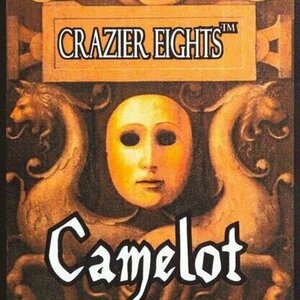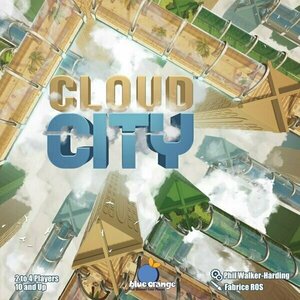
Blink XT Outdoor/Indoor Home Security Camera System
Tech Watch
Meet Blink, the one-of-a-kind, outdoor/indoor, battery-powered remote home monitoring system...
Purple Phoenix Games (2266 KP) rated Crazier Eights: Camelot in Tabletop Games
Dec 23, 2020
War. Old Maid. Go Fish. Crazy Eights. These are classic card games we probably all grew up playing. There have been many re-themes and new difficulty layers spread upon them to make them even more interesting. While UNO certainly has cornered the market on the Crazy Eights base, we have a new contender: Crazier Eights. Recoculous has published several versions of this card game with different themes: Avalon, One Thousand & One Nights, Olympus, and Shahrzad. Today we are taking a preview of Crazier Eights: Camelot.
You HAVE played Crazy Eights right? The card game where you attempt to be the first to exhaust your hand of cards, but you can only play down if you can match the suit or number on top of the discard pile? And if you can’t, you throw down an 8 as a wild and call the color to be played next? Well there you have the easy rules. Crazier Eights: Camelot (which I will from here call C8C) holds basically the same rule-set with a few new mechanics and a theme. The win condition is still the same: be the first to exhaust your hand of cards, but to win you will need to play your hand strategically against your opponents.
DISCLAIMER: We were provided a copy of this game for the purposes of this review. This is a retail copy of the game, so what you see in these photos is exactly what would be received in your box. I do not intend to cover every single rule included in the rulebook, but will describe the overall game flow and major rule set so that our readers may get a sense of how the game plays. For more in depth rules, you may purchase a copy online or from your FLGS. -T
To setup, shuffle the large deck of cards and place the deck in the middle of the table. Flip the top card to begin the discard pile and dictate the first card play. Deal each player seven cards and you are ready to begin!
The turn structure is familiar: check for any “start of turn” effects and apply them, draw a card, play and/or discard a card, then resolve any “end of turn” effects. The deck is comprised of Events and Assets in different colors (suits) and numbers like in a typical deck of playing cards. After checking and resolving start of turn effects on Asset cards in your personal tableau, you must draw a card from the deck. This is where C8C strays from OG Crazy Eights a bit. You may play a card from your hand (Assets and Events) and discard a card to the discard pile (matching the suit/number/or an Eight), or simply play a card from your hand without discarding. Cards played from your hand can be Event cards that are played, resolved, and then discarded to the bottom of the discard pile, or an Asset card that is played to your tableau that cause chain reactions or other abilities on future turns. Next, resolve any end of turn effects from Assets in your tableau before the next player begins their turn.
Play continues in this fashion until one player has rid themselves of their hand and is crowned the Master of the Camelot! Or at least, the winner of the game.
Components. This game is a box full of cards. The cards are good. The layout makes sense, and the art on the faces of the cards remind me of very classic art depicting ancient Arthurian scenes. I am no art historian, so I do not know if they are existing art pieces or new ones crafted for this game, but either way, they are a joy to behold… if you can spend the time appreciating the art instead of tracking what cards you need to play and what effects you can chain together (that was me). Extra points to the Recoculous team for associating symbols with the different suit colors for our colorblind friends. This is something that unfortunately goes unaddressed far too often.
This implementation is the third Crazier Eights we have had the chance to try, and I can say that we really enjoyed our plays of it (we played Olympus first and recently also reviewed Pantheon). The game comes with many interesting and varied effects to craft an ingenious strategy, and the art is stellar. Beware of playing with AP-prone gamers, as there is a lot going on and it is more than just a skinned Crazy Eights.
This Camelot set is slightly different than our previous experiences with both Olympus and Pantheon in a few ways. Firstly, it is more of a base game deck like Olympus instead of a standalone/expansion like Pantheon. Secondly, this set seems to use more cards that affect the assets of other players, specifically in destroying them. Additionally, I have noticed a few cards in the deck that specifically say if certain criteria are met one player automatically wins or loses the game. That’s it. Done-zo. Maybe I missed these cards in the other sets, but I do not remember them ever surfacing. Having each set focus on different aspects of the game and the manipulation of the rules ever so slightly to affect a player’s strategy from one set to the next is quite enchanting to me. Could you put all the sets together to make a massive meta-deck a la Munchkin with all the sets and expansions? Probably, but like Munchkin, I probably would rather keep them separate.
Now having played this family of games several times, I can say that it is my favorite Crazy Eights derivative and certainly worthy of a look. If your game collection is sorely lacking in Arthurian-themed card games, or if you want a hybrid game of old school rules with interesting twists, then do consider purchasing this or one of its predecessors.
PS – Don’t worry if, while you are playing, you have all your Assets stolen or destroyed. I have won the game with zero Assets in front of me while opponents have had eight, ironically. Assets are great, but you still need to shed your hand.
Purple Phoenix Games (2266 KP) rated Yes! Broccoli! in Tabletop Games
Mar 25, 2020
Yes! Broccoli! is a card game for 2-5 players that incorporates blind bidding, special player powers (in advanced games), and drafting elements. The hidden benefit from this game is that healthy food cards are worth more points while the junk food cards are worth negative points (boo and hiss).
DISCLAIMER: We were provided a copy of this game for the purposes of this review. This is a retail copy of the game, so what you see in these photos is exactly what would be received in your box. I do not intend to cover every single rule included in the rulebook, but will describe the overall game flow and major rule set so that our readers may get a sense of how the game plays. For more in depth rules, you may purchase a copy online from the publisher directly, or from your FLGS if stocked. -T
To setup a basic game, each player will take a personal deck of cards numbered 1-8 of the same color border (I choose orange or purple). These are the cards that will be used during the game. Shuffle the large stack of food cards as a draw deck. Draw a number of cards equal to the number of players, determine the starting player and the game is ready to be consumed!
The players will all choose one of their bid cards from their hand and place them face-down in front of them. Once all have chosen, all bid cards will be revealed simultaneously. The highest-bid card’s player will then choose one of the drawn food cards to take into their score pile. That winning player now acts as the dealer and will draw and reveal the next set of cards upon which the players will bid. As the players play all their numbered cards, they may win food cards worth many points, or they may be saddled with negative values as well. These are the junk food cards that nobody wants. Except my son, who wanted all the Candy T-Rex cards, even knowing that it will affect his score. Some people play to win. Others play to have a good time. I admire that about him. Play continues in this fashion until all bid cards have been played. Count up the points won/gathered and determine a winner! This is the basic game to be played with new players or young children.
To play a more advanced game, setup will be the same, except each player will also be dealt two special ability cards to be used during the game. These cards are very powerful, and can only be used once during the game. As this adds a new and thinky layer to the basic game, it is only recommended for older children or adult play. Examples of these special abilities are having the lowest-bid card win instead of highest card, or doubling a bid amount, or adding/subtracting three to/from a current bid.
Components. This game is a big stack of cards in a small (but appropriately-sized) box. The cards are great, and while I would prefer plastic cards for my young kids, children who can respect game components will be just fine. The art on these cards is super cute and I found myself just smiling while I was playing because not only is this game educational for youngsters, but it’s fun to look at while playing too. I made a parenthetical comment about the box being appropriately-sized, and I mean it. I appreciate when a game doesn’t try to be bigger on the shelf for that extra “presence” at the game store. When I open a box and more than 50% is air, it is very irksome to me. How wasteful. Well, not here. We have nothing bad to say about these components at all.
So while most kids may not appreciate the backstabbiness of the special abilities, adults certainly will. That said, when playing with the intended audience of children, we found that Yes! Broccoli! was a huge hit! We are still working on the younger kids and breaking them of the, “yes, the cake princess is very pretty, but you really don’t want to take her into your score pile.” Winning and losing really doesn’t matter much in the Lopez household, but gaming experiences do, and though my son doesn’t win this one ever, he loves it, and I love playing it with him. So I consider this a win, and though our official Purple Phoenix Games rating has a caloric value of 8 / 12, I do believe you will enjoy this little card game – ESPECIALLY if there are little ones in your life. Purchase it directly from the publisher at Gangway Games. You can use it as a precursor to Munchkin and Cutthroat Cavern, or as a stepstone to bidding games like Biblios and No Thanks!

Wrestling Revolution
Games and Sports
App
"Leagues ahead of its major league counterparts." - Bullz-Eye Tap, pinch, and swipe your way...
Purple Phoenix Games (2266 KP) rated Matryoshka in Tabletop Games
Apr 8, 2022
Matryoshka is a card game of hand management and set collection in which players are antique collectors attempting to gather complete sets of valuable Matryoshka dolls. Over the course of 4 rounds, players will be trading (in a sort of auction/bidding way) cards in their attempts to collect different sets of numerically ascending Matryoshka dolls. To setup for a game, you will first create the game deck. Depending on the player count, you will use a specific number of Matryoshka sets for the game – each set ranging from values 1-7. Shuffle the deck and deal 6 cards to each player, placing the remaining cards in the middle of the play area in a face-down draw deck. Players will then select 2 cards from their hand to place in their Display (tableau), organized as described in the rules. Cards in your display are visible to all players, and provide information as to what cards you have, and what cards you may be looking for. So deciding which cards to Display is part of your strategy. Select a starting player, and the game is ready to begin! Pictured below is the setup for a four-player game.
Each round is consists of 3 phases: Draw, Exchange, and Display. To begin the round, all players will draw 2 new cards from the deck. The Exchange phase is played in turns, beginning with the starting player as the active player. The active player will select one card from their hand to be placed face-up in the middle of the table. This is the card that is up for trade. All other players must then choose one card from their hands to be offered in exchange. Players keep their offer cards hidden, and the active player will secretly look at all offer cards. The active player then chooses one of the offer cards to take into their hand, and the player whose card was chosen takes the active player’s face-up card. All other players take their offer cards back into their own hand. Play then moves clock-wise, beginning another Exchange with a new active player.
When all players have had the opportunity to be the active player, the game moves to the Display phase. Players take all cards from their Display into their hand, and will then create a new Display. As the game rounds progress, the number of cards in each Display increases. To start the game, all players Display 2 cards. After the first round, the Display will have 4 cards, then 6, 8, and finally 13 to end the game. Again, cards in your Display are visible to all players, and that information could be used strategically when Exchanging cards in the second game phase. After the fourth and final round, players will have a total of 13 cards in their Display. Each Display is now scored, earning points for consecutive cards per row as well as sets of the same size of doll. The player with the highest total score is the winner of the game!
I should probably start by saying that I’m a sucker for set collection. So when I stumbled across Matryoshka, the theme drew me in and the set collection mechanic prompted me to hit ‘Add to Cart.’ And I have to say that I am loving this game. One major element that I like about Matryoshka is the simplicity of the gameplay. Draw 2 cards each round, offer cards from your hand in Exchange for others, create Displays of your sets. Easy as pie.
What really takes this game above and beyond for me are the strategic elements. Deciding which cards to Display at the end of each round is a major strategy point of the game. You have to be careful with which cards you choose to Display, because they are visible to all players. So maybe you’ve got a set of 5 consecutive cards, but do you really want your opponents to know that? Is it better to only Display a couple and use other sets to finish your Display? Or maybe you do want people to know you’re gunning for that set, as it may prompt them to offer any of those cards from their hand, for which you would pay a pretty price. You scratch my back, I’ll scratch yours, right? Along with that comes the negotiation tactic. During every Exchange, players are allowed to try to influence the active player for certain trades. Take my card now and I’ll owe you a favor later sort of thing. It’s neat to see what strategies players will try with each passing round.
ALSO it pays to pay careful attention to all opponents each round. When creating your Display at the end of every round, you do not have to use the same cards as in your last Display. So you can strategize to bait opponents to giving you cards you want, or to try and keep your chosen sets secret. That being said, paying attention to opposing Displays can be a good tactic. Maybe your neighbor just had a consecutive run of 3 cards in their Display, but now are choosing to only Display 1 of those cards – just because you can’t see the others, doesn’t mean they’re not necessarily there. So changing up Displays can be a way to maybe trick your opponents into thinking you do or do not have specific cards. If you keep a careful eye out, you may be able to deduce what everyone is hiding…
A quick note on components – this game is a stack of cards in a small magnetically-closing box. The artwork is thematic and unique, the rules and scoring aids are understandable, and the box itself is nice and sturdy. The cards are not the most high-quality I’ve seen in games, but as long as my players are gentle, that shouldn’t be a problem in the long run.
So all in all, I think you can tell that I love Matryoshka. The gameplay is simple and fast, yet the strategic options really get you thinking and perhaps second-guessing every Exchange that is made. I really like the element of changing Displays at the end of every round, as it allows players to adapt their strategy for the coming round. I wasn’t really sure what to expect when I picked up this game, but I was pleasantly surprised. It’s one that I’m definitely happy to have, and can see myself pulling it out often for a quick, yet strategic game between some of the bigger games out there. To bring back my analogy from my intro (yep, I’m committed to this joke), I would say that Matryoshka is nearly as satisfying as playing with a physical set of nesting dolls. If you’re looking for something light yet engaging, I would definitely recommend picking this one up. Purple Phoenix Games gives Matryoshka a nestled 5 / 6.

Mobile B@nking
Finance and Business
App
Sucursala din buzunarul tau, cu zero costuri de administrare. Mobile Banking are o navigare...

PromptSmart Pro - Teleprompter
Photo & Video and Productivity
App
PromptSmart is the first and only “smart” teleprompter app. VoiceTrack speech recognition...

LiquidText PDF Reader
Productivity and Education
App
*** Named “Most Innovative App of 2015” by Apple App Store *** LiquidText offers a fast,...

LiquidText Enterprise
Business and Productivity
App
* Includes the same features as our consumer version of LiquidText, but designed to work with...
Purple Phoenix Games (2266 KP) rated Cloud City in Tabletop Games
Oct 21, 2020
Cloud City is a tile and building placing game for two to four players that is super light and super quick to play. In it players are building architects attempting to plan the greatest use of resources to create the most breathtaking buildings and connections of walkways all above the clouds. The winner is the player who amasses the most City Council votes by creating walkways that span daring lengths and connect same-sized buildings in the sky.
DISCLAIMER: We were provided a copy of this game for the purposes of this review. This is a retail copy of the game, so what you see in these photos is exactly what would be received in your box. I do not intend to cover every single rule included in the rulebook, but will describe the overall game flow and major rule set so that our readers may get a sense of how the game plays. For more in depth rules, you may purchase a copy online or from your FLGS. -T
To setup set aside the starter Cloud tiles for use as player tiles (they have bird icons on them). Shuffle the remaining Cloud tiles and make a giant draw stack. Reveal three tiles for an offer row. Each player draws three Cloud tiles into their hand to be kept secret from the other players. They also will take the appropriate building pieces to place on their starting tiles. Keep the building pieces nearby as they will be used during the game. Players may now begin their bids for architect supreme!
On their turn each player will place a tile from their hand to add to their city, place the corresponding building pieces on the two areas of the tile, optionally build walkways to connect buildings, and then refill their hand of tiles.
When placing a tile, a few rules must be observed: tiles must be placed orthogonally adjacent to an existing tile in the city, may be rotated any direction, and must never be placed outside of a 3×3 tile grid (like the placement rules in Kingdomino).
Once tiles are placed, grab the matching-colored building pieces for the newly placed tile and plop them down on the icons. As the building in the city begin the spring up above the clouds they will need to be connected to buildings of the same height.
To connect these buildings players will take from the supply walkway tokens of different lengths and place them between building of matching height, as shown below. It is these walkways that score the players points as votes from the City Council.
As the player now has only two tiles in hand, a third tile will need to be drawn from either the offer row or blindly from the top of the draw pile. It is now the next player’s turn and the game ends once all players have built their 3×3 city!
Components. This game consists of a bunch of thick cardboard Cloud tiles (48), a bunch more walkway tokens (93), and even more building pieces (96). The tiles are all thick cardboard with minimal but effective art, and are great quality. The walkways are similar thickness and quality and fit into the depressions on the building tops quite nicely. And finally, those building pieces. Oh man, these are great! Super durable plastic (or resin if there’s a difference? I was never very good at chemistry) in three colors and heights. Not needed but certainly appreciated is the detail on each piece with sculpted windows and doors. These are fun pieces to handle during game play and see being built in front of you. Excellent components in this box!
Gameplay is super simple and quick! There are only four real rules to remember (with some restrictions per rule, but they make sense) and as there are only three tiles in hand to build on a turn, AP-prone gamers will still be able to take acceptable-length turns. It’s quick, light, and boasts some great components.
Cloud City is a sure-fire hit and big time winner for me. In fact, I am planning on having my 4-year-old play it with me to truly test the box stating ages 10+. If I can get him to sit still for 30 minutes and concentrate on something other than the tablet or TV I think he will really enjoy it. If you are looking for a great gateway game that even could act as a filler with great components and gameplay that makes you consider the old, “Just one more” attitude, then give Cloud City a look. Blue Orange Games has really increased their production values and choices of games to release. They are remarkable! Just like Cloud City: remarkable!



